The PolarTREC Field Experience
PolarTREC (Teachers and Researchers Exploring and Collaborating) is a program that pairs US educators with researchers for field science experiences in the Arctic and Antarctic. For people like me, it is exciting to note that the program is now open to informal science educators as well as formal K-12 teachers. PolarTREC is managed by the Arctic Research Consortium of the United States (ARCUS) and receives funding from the National Science Foundation (NSF) Office of Polar Programs. The long-term vision of PolarTREC is "to create and sustain a successful approach to professional development in the polar regions, fostering enthusiasm and awareness to inspire the next generation of scientists and a STEM-literate public." (https://www.polartrec.com).
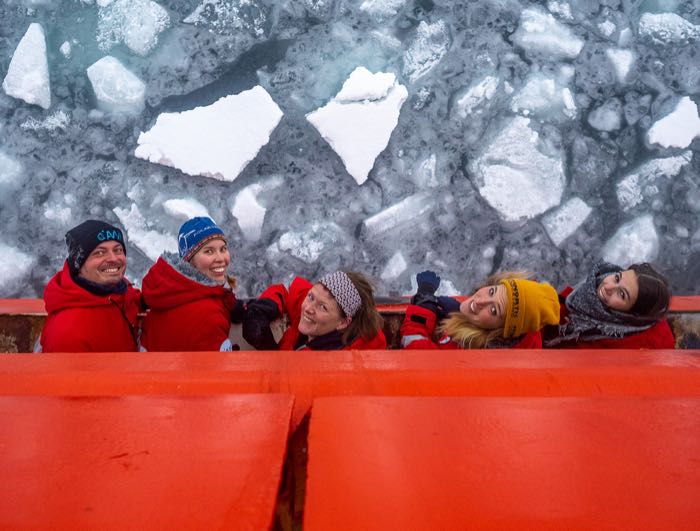
The Expedition Explained
I've heard a lot of superlatives thrown around by media covering the MOSAiC Expedition: 'biggest', 'most ambitious', 'most massive', 'largest', 'one-of-a-kind', and 'once in a generation' seem to be the most common. In lieu of those grandiose adjectives, I'd like to suggest something a little bit different: interconnected. What stands out to me most about the MOSAiC science is how interconnected all aspects of the Central Arctic environment are; similarly, I am impressed by how this expedition has to inter-connect different researchers, logistics teams, support staff, ship crews, helicopter and plane pilots, journalists, and educators from vastly different geographies, languages, experiences, and demographics. Hundreds of people will spend time physically on the sea ice conducting research through this project, and I don't think it is an exaggeration to say that there are hundreds more supporting the work remotely. This is a remarkable endeavor, and the coordination across different groups and nations is inspiring.
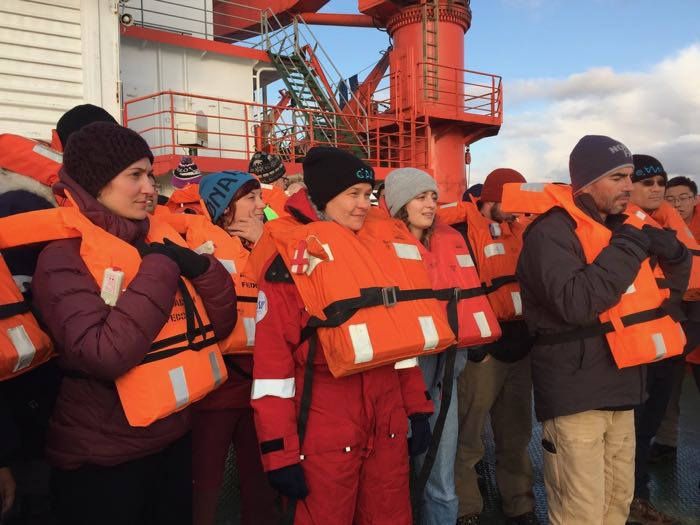
The goals of the expedition are to study the coupled systems of atmosphere, cryosphere (ice), hydrosphere (in this case, ocean) and biosphere (living things) in the Central Arctic Ocean across the seasons; they are especially interested in how these systems influence each other in a changing-Arctic and at different times of year, and how changes to these systems may have global impacts. To do this, the expedition team has frozen the German research icebreaker Polarstern into a floe of sea ice. There, it will drift with the sea ice across the Central Arctic Ocean and serve as the home base for scientists as they conduct research and collect data at the nearby ice camp. Some researchers will also deploy equipment and collect data directly from the ship itself. The expedition is slated to last approximately a year, and the initial start sit was chosen based in part on the probability that the transpolar drift will carry this ice floe -and the Polarstern - from north of Siberia, across the Central Arctic Ocean in close proximity to the North Pole, and then into the Fram Strait and North Atlantic Ocean.
Setting the Stage
Everything for MOSAiC revolves around the main ice camp on the floe Polarstern is freezing into. This means that once Polarstern reached the Central Arctic Ocean, no further major steps could take place until they found their ice. In order to moor the Polarstern and set up the sea ice research, they needed to find an ice floe that meets lots of criteria. It had to be large enough to set up all the equipment and the airstrip. Some equipment needed to be isolated from other components, so the floe needed to be more than 1-2 miles across. The floe also needed to be thick enough to safely support people and equipment for an entire year - including the summer melt season. They searched for about 1-1.5 meters (3-5 feet) thickness near the center of the floe. They also looked for an area that doesn't have many melt ponds. Melt ponds are areas where meltwater pools on top of the sea ice during the summer season. Melt ponds are dangerous to work around and can cause the ice to break up sooner. The ice they sought had to be fairly consistent in thickness too, so that it is less likely to break up into pieces due to wind or current stress. At the same time, there needed to be enough variability so that the researchers can study and compare different types and thicknesses of ice.

Finally, the ice had to be located in the right area. The researchers use predictions of sea ice drift to figure out where the Polarstern should start. They want it to drift across the Central Arctic Ocean and out into the Fram Strait. They don't want it to go towards Alaska or towards the Russian coast. Models and forecasting give them a very good idea of where the ship needed to start in order to accomplish this. So they had to find an ice floe within this target start area. After days of searching by the Polarstern and Akademik Fedorov, and input from ice analysts of many nationalities, a suitable ice floe was finally found. It was nicknamed the 'ice castle' and 'ice fortress'. Logistics crews and researchers promptly began setting up the ice camp on this floe, running thick power lines to provide electricity for lighting on the ice (since there is no daylight for multiple months at a time!), scientific equipment and small warming sheds where researchers can take shelter while working on the ice all day. Oceanographic buoys and a 15-meter meteorological station were set up. An area was created for ROV (remotely operated vehicle) work, and two areas for biological sampling - one with artificial white light and one where only red lights are allowed.
As the Polarstern team set up the ice camp, those of us on the Fedorov began working on getting the distributed network established. The idea with the distributed network is to gather information on ice, air, and ocean conditions and processes throughout the year surrounding the main research site. We deployed a variety of buoy sensors and meteorological stations 5-20 miles from Polarstern's main ice camp. This information will help put the data from the ice camp into a broader context. It will also allow researchers to check how representative that area is, or if there is a lot of variability across a few miles. And the datasets from the distributed network will be valuable on their own. Some research can only take place away from Polarstern because of the specifics of the sea ice conditions they want to study or the need to be farther away from the heat and emissions from Polarstern itself.
Overall, there are 3 L-Sites, 8 M-Sites, and more than 30 P ice buoy sites. More equipment was deployed at the L-Sites; therefore, these floes had to be fairly big and thick - though not the ice fortress of the main site. First, some options were identified using satellite images. These choices were then checked by a helicopter team and ice coring.
That was the important work that was happening behind the scenes, led by the Russian Arctic and Antarctic Research Institute. But for most of us, the excitement came when we were finally able to get out on the ice! First, 3 people went to check ice conditions and do a scan for polar bears around the L1 site. Four more of us were on Polar Bear Watch in the bridge, scanning the icy landscape with binoculars for anything moving or a different shade of white than the snow and ice. It was a great place to be at that time; I got an insight into how decisions are made regarding where equipment and pathways will be placed on the ice, and I got to watch the sunrise while looking for bears.
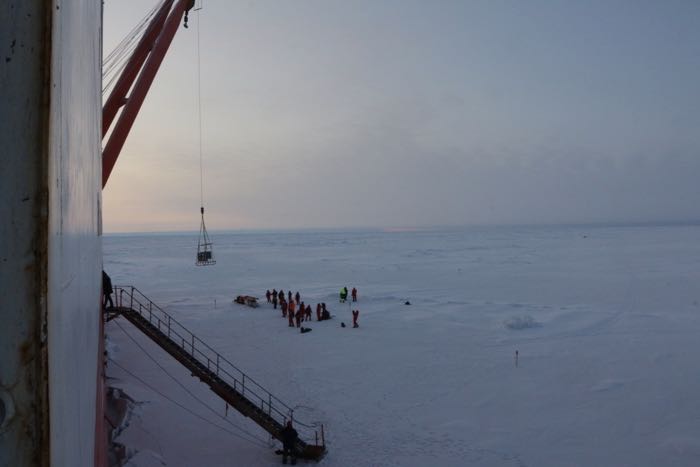
After the survey crew gave the thumbs up on ice thickness, more than 30 researchers, graduate students, and logistics support people headed out onto the ice floe. The crane unloaded gear and snowmachines onto the floe. Meanwhile, people suited up in cold-weather gear and stepped down the gangway. Two snowmachines revved up and began moving ice drills and buoys and gear to specific spots on the ice.
The list of sensors and buoys that were deployed is staggering. The key pieces of equipment used on the L-sites are an Ice-Tethered Profiler, an Autonomous Ocean Flux Buoy and Pycnocline Spar, a Seasonal Ice Mass Balance buoy, a Snow Buoy, an Ice-Tethered Bio-Optical Buoy, and a Meteorological Station mounted on a sled. Most of these pieces of equipment weigh between 100-600 pounds and require significant gear to set them up. At the same time, a small crew traversed the extent of each M-site using a snow probe and GEM sled to measure snow and ice thickness. Others collected ice cores to measure ice thickness and to analyze for trace gases like methane and sediments.

I was fortunate to be included in the group work on the ice. I assisted with the set up of the meteorological station at each L site. I also helped to deploy buoys that will collect information on ocean currents, water temperature, water salinity, and much more. It is a huge challenge to assemble everything in a cold environment with limited daylight (or really dusklight). It takes a lot of coordination amongst the scientists, and excellent support from bear guards and the ship's crew.
The meteorological sled has a variety of interesting sensors that measure wind, temperature, snow depth, humidity, and much more. The team, mostly from the University of Colorado, is especially interested in the energy budget under different ice conditions. How much shortwave radiation (solar energy) passes through the atmosphere and is absorbed by and into the ice? How much is deflected by different cloud formations? And how much is reflected by the ice, something determined by the albedo of the ice under different conditions (such as snow-covered melt ponds, 'rotten ice' algal growth, etc.). They also are interested in how much longwave radiation is emitted by the ice, and how much incoming longwave radiation there is under different cloud conditions. The instrument they use to measure this is called a radiometer. In addition, they use a very sophisticated anemometer, which measures wind in 3 directions, to understand the movement of heat and moisture in the ice-atmosphere boundary. The number of cables and wires required is remarkable and overwhelming, especially when your hands are very, very cold. Only by working together, and a little creativity, were we able to get everything assembled.
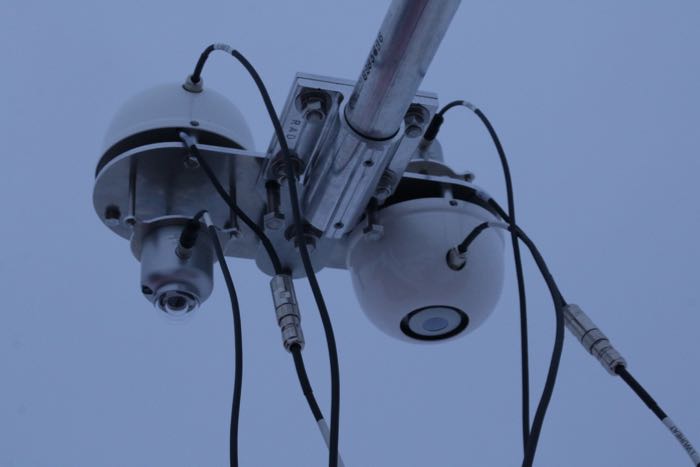
The equipment at the L sites will be visited by researchers for maintenance and trouble-shooting every 1-2 months. Data from the equipment is being transmitted via an Iridium network to the Polarstern, and some are even available online now through the Woods Hole Oceanographic Institute and the Naval Postgraduate School. Meanwhile, researchers at the main ice camp have a weekly schedule of sampling and data collection. Sometimes their work is interrupted by polar bears, storms, or newly formed cracks in the ice, but that is the reality of research in the Arctic environment. Despite these challenges, together they are building knowledge that will help the world to better understand, prepare for, and adapt to the complex implications of climate change in the Arctic.
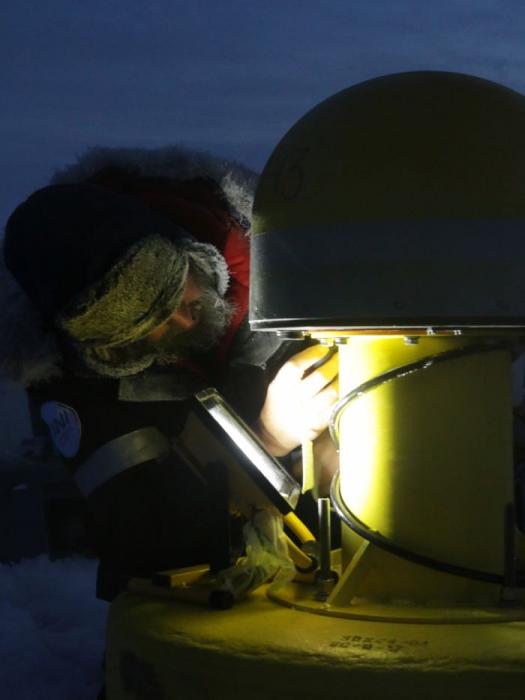
The Importance of Educator/Researcher Collaboration
Over the course of my time on the Fedorov, I interviewed and spoke with many scientists across many disciplines. One of my favorite questions to ask was, "What would you want a 10-14-year-old student to know about the topic that you study?". I think this question was intriguing to many of the researchers. There was often laughter, smiles, and excitement as they thought about their answers. It seemed that the question sparked their own thinking about what is most important to understand about their research and reminded them of what makes their work interesting, unique, and valuable. This, I think, is one of the sometimes- surprising but valuable benefits of collaboration between educators and researchers: educators, through asking novel questions and thinking about things in an unorthodox way, can help to re-ignite and fuel curiosity, passion, and enthusiasm among researchers. Things that are routine and probably boring for researchers, become fascinating and important when seen through the eyes of an educator. Because educators often seek to tie the details of research into big-picture impacts and broad concepts, we can push researchers to consider connections and implications they hadn't before.

In the context of a major expedition like MOSAiC, where there are multiple disciplines working together, it also can be very beneficial to include an educator who is willing to ask 'stupid' questions. Because there isn't much expectation that the educator will fully understand the scientific concepts and processes involved, we are often granted space to ask clarifying questions or pose naive ideas. This can be especially useful to other members of the research team who have different areas of expertise. In this way, educators can help to bridge knowledge gaps between those studying different aspects of the system. At times, as an educator with a focus on climate change and coastal ecology, there were even times when my scientific knowledge from southcentral Alaska was actually interesting and relevant to the researchers. This was a wonderful surprise and a further extension of collaboration across disciplines.
Many researchers involved in MOSAiC were also eager to discuss their own efforts and ideas in outreach and education. Over meals and during free time, for example, we brainstormed activities for a kinesthetic activity for an ice researcher's spouse's kindergarten class and art projects to mimic the microscopic life living in the brine channels of sea ice. Generally, there was a lot of interest in learning more about place-based, experiential, and culturally-responsive education and I was happy to be able to engage in these discussions.
The benefits of the collaboration, of course, are mutual. As an educator, I am still marveling at how much I learned through this experience. Being physically present in the Central Arctic Ocean was a surreal and astounding experience. I got to FEEL what it is like to do research in this environment, to walk on the sea ice, to hear ice shift groan and shift under pressure. My fingers went numb trying to screw small cables together to get meteorological sensors linked to a data processor, and my nostrils froze together. I found out how quickly you adjust to 4 meals a day, and how strange it is to switch time zones over and over and over and over again each day. I discovered that when the seas are rough it is much easier to do a push-up when the ship is cresting over a wave, and nearly impossible when it is moving down into the trough. I watched polar bears walk across very thin ice, and a cub play with a chunk of ice floating in a small lead. I all-at-once experienced them as curious, beautiful, awe-inspiring, and dangerous. I saw sea birds follow our wake through the ice, eager for the bits of life under the ice we might kick up. This was an enlightening and inspiring experience, to say the least.
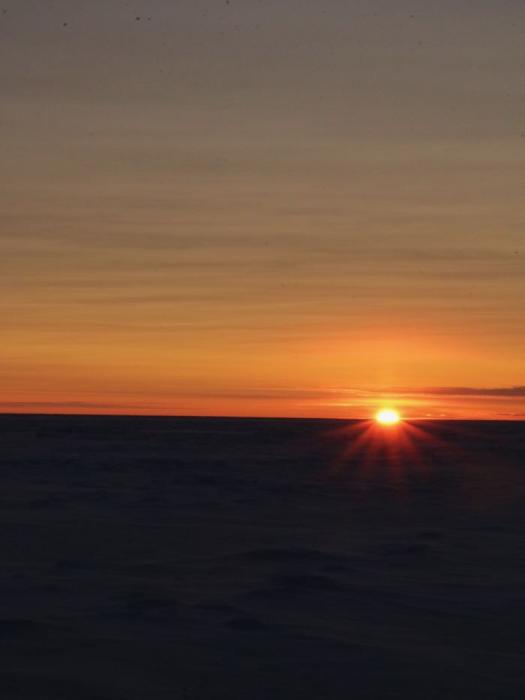
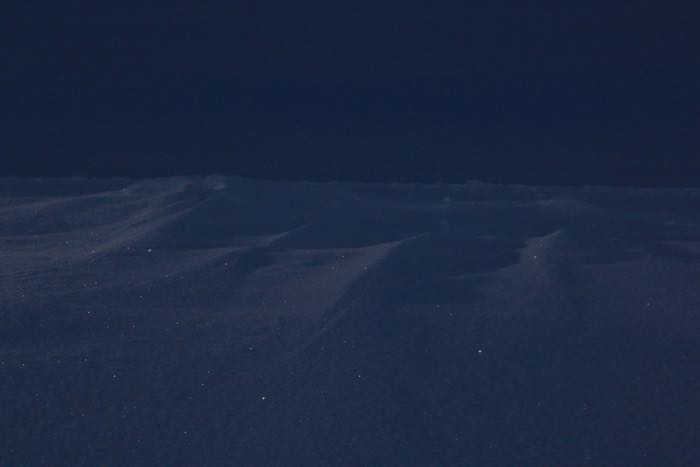
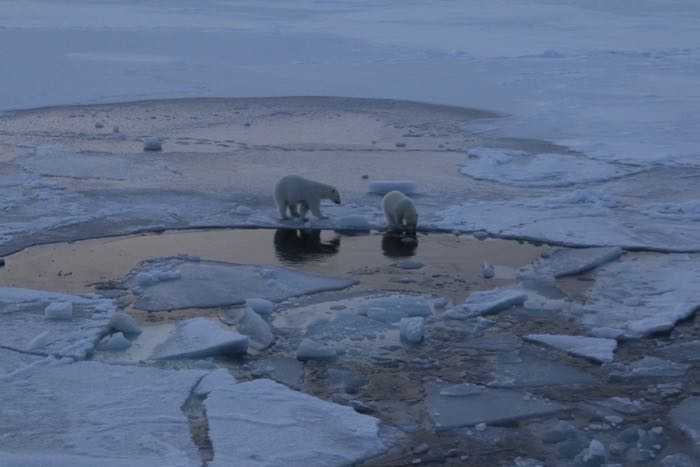
Beyond the direct experience of research and life in the Central Arctic Ocean, I dearly value the time that I was able to spend learning from the scientists, crew, and logistics staff while discussing their work. If I had a question or idea about nearly anything Arctic science-related, I could usually find someone who was eager to talk about it with me. This extended beyond the science of MOSAiC to include such topics as sub-sea permafrost as an analogue for interplanetary research, the experiences of being a polar bear guard, the mental health and physical challenges of living with one other person in a small ice camp for 9 months(!) and the need for climate scientists to mitigate the carbon footprints of their research and travel. Through a million small conversations, I bolstered my understanding of both global phenomena and specific Arctic science topics. More importantly, I now have a network of people that I can reach out to overtime to further my learning, and double-check that I am communicating it accurately for students and public audiences. This network is part of the most important thing I gained from the MOSAiC expedition and participating in PolarTREC: a collaborative community of scientists, educators, and journalists committed to better understanding and communicating about the Arctic environment and our changing climate, for the benefit of human and natural communities.
Linking PolarTREC To My Institution and Community
I am currently working on how best to bring my experience from the Central Arctic Ocean into the environments and contexts where I teach. As a place-based, informal educator it is both challenging and exciting to figure out how best to connect research and experience in the Central Arctic Ocean - a place most students will never experience for themselves - with students' lived experiences and knowledge in southcentral Alaska and other locations where I partner with teachers and educators. I am approaching this challenge in three main ways.
First, I am developing games, experiments, and hands-on outdoor activities for learners to investigate and model key Arctic processes and compare them to more local environments. For example, I am working on a series of investigations with simulated sea ice (seawater carefully frozen in a specific way) and local ice from lakes and marsh areas so that students can relate and compare Arctic sea ice with more familiar types of ice. I am also adapting activities based around local species of plankton to introduce students to the incredible variety of adaptations plankton use to thrive in the Arctic as well as temperate environments. I will share these resources with other educators, and will also utilize them in Alaska Coastal Ecology and Onboard Oceanography field trips that I lead with the Center for Alaskan Coastal Studies (CACS) as well as after school programs and summer camps. Many of these activities will also be incorporated into MOSAiC curriculum being designed by a team at the University of Colorado.
Secondly, I am building supporting materials around existing community-based monitoring and citizen science programs (like GLOBE, CoCoRaHS, and harmful algal bloom monitoring) that highlights the ways these programs focus on parameters similar to those researched during MOSAiC. My hope is to help educators and students link the complex field research done with sophisticated instruments in the Arctic with related and important data collection they can do in their own backyards that will contribute to understanding local and global climatic change and impacts. These resources will be used by myself and other staff at CACS and shared broadly across my educational network. Some of them will likely also be included in the MOSAiC Curriculum.
Finally, I am slowly creating a group of environmental education centers and other informal learning environments interested in focusing aspects of their programming on Arctic science. Before the trip, I shared the first installation of simple, fun, and informative activities that these institutions could provide to their audiences. I will continue to send out thematic activity ideas over the course of the year, and I hope to grow both the geographic scope of this group and the number of participants. The themes will follow seasonal events in the Arctic and seek to link broadly experienced phenomena (like the winter solstice, mass migration, spring 'green-up') with Arctic-specific examples. The first set of resources were focused on understanding the science of the equinox, with a number of experiments, outdoor observations, demonstrations, and art projects that could be used with youth participants or even some public audiences.
In addition to these three strands, which are focused on youth education, I will be participating in a number of events in Homer targeting adult audiences. Prior to my PolarTREC trip, I set up question boxes around town for people to submit their queries about the expedition, Arctic science, and climate change. There was a lot of interest and curiosity about my trip, and a number of local people followed my PolarTREC journals and posted questions. I am eager to foster their enthusiasm as the MOSAiC expedition continues over the next year. I am presenting a 'Tuesday Night Lights' community education event at the Center for Alaskan Coastal Studies in January, and will also be speaking to science writing and biology classes at our local community college. The Kachemak Bay National Estuarine Research Reserve has invited me to speak at a brown bag lunch series, and Grace Ridge Brewing is interested in an evening brewery talk. I did an interview with the local radio station, KBBI, before my trip and plan to do a follow-up interview soon. CACS does monthly presentations at the local senior center, and I will focus one on my MOSAiC experience. We also lead a monthly story hour at the library for preschoolers and their parents/caregivers; I've already picked out some awesome children's books about the Arctic that I want to share along with photos from my experience. With regard to teachers, I will be co-presenting a session on MOSAiC curriculum and educational activities at the National Science Teaching Association conference. CACS generally leads 1-3 teacher workshops each year based in Homer, Alaska and I am very excited to include many of the activities that I design and community-based monitoring projects into those workshops.
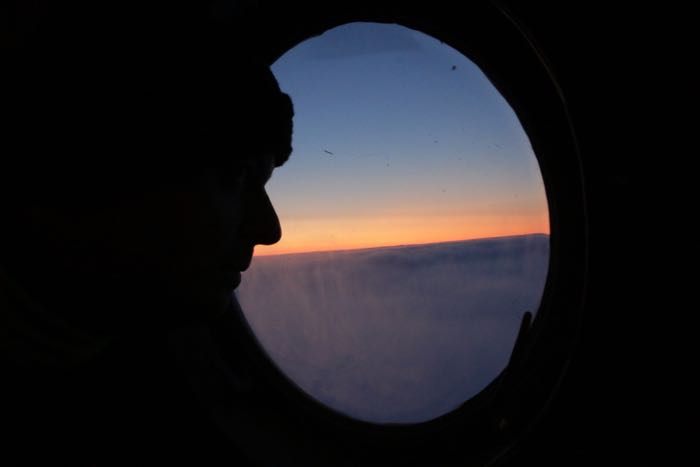
The Bigger Picture
We are all connected to the Arctic, and the Arctic is influenced by all of us. Participating in MOSAiC and PolarTREC has equipped me to better understand, communicate, and teach about emerging Arctic science and climate science now and in the future. Through this experience, I have become ever-more committed to engaging with this science and helping others to understand it within the contexts of their own lives and experiences.
*This program is supported by the National Science Foundation under award 1918637. Any opinions, findings, and conclusions or recommendations expressed by this program are those of the PIs and coordinating team, and do not necessarily reflect the views of the National Science Foundation.
| Attachment | Size |
|---|---|
| Download Report1.05 MB | 1.05 MB |
This program is supported by the National Science Foundation. Any opinions, findings, and conclusions or recommendations expressed by this program are those of the PIs and coordinating team, and do not necessarily reflect the views of the National Science Foundation.
